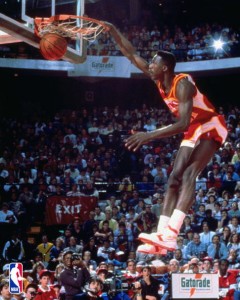[In my January 1, 2015 post, I christened this the “Year of Learning” here on the blog. Each post, I’ll aim to share something recently discovered (or re-discovered) in the hope that you might add my learning to your own discoveries and make double-moves forward and upward this year!]
 I used to love watching Dominique Wilkens dunk a basketball. His explosive vertical and his wild windmills always made me think he was the best at that particular hoops skill. Wilkens recently sat down with CBS Sports to share a memory from his rookie season, from the first time he played against Larry Bird:
I used to love watching Dominique Wilkens dunk a basketball. His explosive vertical and his wild windmills always made me think he was the best at that particular hoops skill. Wilkens recently sat down with CBS Sports to share a memory from his rookie season, from the first time he played against Larry Bird:
“One of the first times I ever played against him, I went out for the opening tip and I went to shake his hand. He just stood there and looked at me stone-faced with his hands behind his back,” Wilkins said recently.
“I was like, ‘Whoa.’ Then we were getting ready for the tip and he says to me, ‘You don’t belong in this league, Homes.’ I couldn’t believe it, but it happened so fast, I didn’t know what to think.
“Then they had the ball and I was on him and he said, ‘I don’t know why they got you guarding me, Homes. You can’t guard me.’ Then, whap, he hit a 3. Then he came down again and said, ‘They made a mistake putting you on me, Homes,’ and he took another 3.”
Getting into the story, Wilkins began to act things out with his facial expressions.
“So now I’m hot,” he said. “I’m hot. I mean, I’m steaming.
“Then a little while later, I came down on a break and he was backpedaling. I just went right after him. I jumped up and he tried to challenge, but I took that right through the rim. He fell and hit the basket support.
“He got up and said, ‘I like you, rookie. You’ve got(guts).’ I was happy for a second, and then he said, ‘But I’m still going for 40 on you tonight.’ ”
He then paused the story, stepped back and smiled.
“But I got him,” Wilkins said. “He only scored 39.”
Smile.
So today’s lesson: Don’t expect graciousness anytime soon if you’re asked to guard Larry Bird at local pick-up game. 🙂






